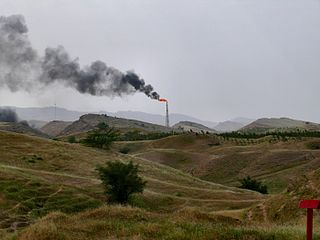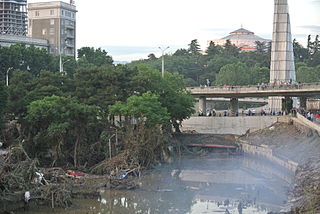Related Research Articles

Water pollution is the contamination of water bodies, usually as a result of human activities, so that it negatively affects its uses. Water bodies include lakes, rivers, oceans, aquifers, reservoirs and groundwater. Water pollution results when contaminants mix with these water bodies. Contaminants can come from one of four main sources: sewage discharges, industrial activities, agricultural activities, and urban runoff including stormwater. Water pollution is either surface water pollution or groundwater pollution. This form of pollution can lead to many problems, such as the degradation of aquatic ecosystems or spreading water-borne diseases when people use polluted water for drinking or irrigation. Another problem is that water pollution reduces the ecosystem services that the water resource would otherwise provide.
Environmental pollution in Japan has accompanied industrialization since the Meiji period. One of the earliest cases was the copper poisoning caused by drainage from the Ashio Copper Mine in Tochigi Prefecture, beginning as early as 1878. Repeated floods occurred in the Watarase River basin, and 1,600 hectares of farmland and towns and villages in Tochigi and Gunma prefectures were damaged by the floodwater, which contained excessive inorganic copper compounds from the Ashio mine. The local breeders led by Shōzō Tanaka, a member of the Lower House from Tochigi appealed to the prefecture and the government to call a halt to the mining operations. Although the mining company paid compensatory money and the government engaged in the embankment works of the Watarase River, no fundamental solution of the problem was achieved.
Kazakhstan, has serious environmental issues such as radiation from nuclear testing sites, the shrinking of the Aral sea, and desertification of former agricultural land. These issues are due in large part to Kazakhstan's years under the Soviet Union.

Environmental issues in Venezuela include natural factors such as earthquakes, floods, rockslides, mudslides, and periodic droughts.

Environmental issues in Indonesia are associated with the country's high population density and rapid industrialisation, and they are often given a lower priority due to high poverty levels, and an under-resourced governance.
The major environmental issues in Kyrgyzstan, are summarized in the 2007 Concept of Ecological Security of Kyrgyz Republic and discussed in other environmental and environmental policy documents such as National Environmental Action Plan (1995), Country Development Strategy for 2009–2011, Strategy on Biological Diversity (2002), 2nd Environmental Performance Review of Kyrgyzstan (2008), etc.

Environmental issues in Iran include, especially in urban areas, vehicle emissions, refinery operations, and industrial effluents which contribute to poor air quality. A report by the United Nations Environment Programme ranked Iran at 117th place among 133 countries in terms of environmental indexes. Water scarcity is a serious issue, and the country is also threatened by climate change.
Environmental issues in Pakistan include air pollution, water pollution, noise pollution, climate change, pesticide misuse, soil erosion, natural disasters, desertification and flooding. According to the 2020 edition of the environmental performance index (EPI) ranking released by Yale Center for Environmental Law & Policy, Pakistan ranks 142 with an EPI score of 33.1, an increase of 6.1 over a 10-year period. It ranked 180 in terms of air quality. The climatic changes and global warming are the most alarming issues risking millions of lives across the country. The major reasons of these environmental issues are carbon emissions, population explosion, and deforestation.
Environmental issues in Tajikistan include concentrations of agricultural chemicals and salts in the soil and groundwater, poor management of water resources, and soil erosion. Additionally, because of inadequate sanitation facilities, untreated industrial waste and sewage combine with agricultural runoff to cause water pollution in the Aral Sea Basin. Soviet-Era mining operations in Tajikistan extracted and processed uranium, gold, antimony, tungsten, mercury, and molybdenum, each of which is known to leave toxic waste that also threatens water quality. Pockets of high air pollution caused by industry and motor vehicles have resulted in Tajikistan ranking 133rd in the world in greenhouse gas emissions. Air pollution is a particular problem during times of the year when atmospheric conditions hold industrial and vehicle emissions close to the surface in urban areas. In summer, dust and sand from the deserts of Uzbekistan and Turkmenistan cause air pollution across the entire southwestern lowland region.

The environment of Belgium is generally affected by the high population density in most of the country. However, due to consistent efforts by the various levels of government in Belgium, the state of the environment in Belgium is gradually improving. These efforts have led to Belgium being ranked as one of the top 10 countries in terms of environmental protection trends. However, water quality still suffers from a relatively low, yet increasing percentage of sewage waste-water treatment, and from historical pollution accumulated in sediments. Air quality is generally good to average, but is affected by emissions from traffic and house heating, and industrial air pollution blowing over from the neighboring heavily industrialized Ruhr-area in Germany. Biodiversity is lower in Flanders than in Wallonia because of population density and fragmentation of habitats, but efforts are being made to boost bio-diversity through connecting fragmented forests and national parks through wildlife crossing "ecoducts" such as in Kikbeek.

There are multiple environmental issues in India. Air pollution, water pollution, garbage, domestically prohibited goods and pollution of the natural environment are all challenges for India. Nature is also causing some drastic effects on India. The situation was worse between 1947 through 1995. According to data collected and environmental assessments studied by World Bank experts, between 1995 through 2010, India has made some of the fastest progress in addressing its environmental issues and improving its environmental quality in the world. However, Pollution still remains a major challenge and opportunity for the country.

Environmental issues in Russia include pollution and erosion, and have impacts on people, wildlife and ecosystems.
Cuba possesses a diverse range of natural habitats, housing a wide variety of species, including many endangered ones. However, the country has faced environmental challenges, particularly deforestation, since the arrival of European settlers. Forest areas have been cleared for agricultural purposes, leading to the loss of forests and the extinction of certain species. The cutting down of trees for fuel and construction materials has further contributed to this issue.
There are a number of known environmental issues in the post-communist country of Albania. Issues include air and water pollution, poor waste management infrastructure and deforestation. The Albanian environmental movement includes around 40 active non-government organisations.

Environmental issues in Serbia include air pollution, deforestation, various categories of threat to endemic species and climate changes. Several environmental organizations operating in Serbia have protested the government's handling of these issues.

Environmental issues in Singapore include air, water pollution, and deforestation. The government established the Singapore Green Plan in 1992 to help with environmental issues.

Environmental issues in Chile include deforestation, water scarcity, pollution, soil erosion, climate change, and biodiversity loss, especially in its industry-heavy "sacrifice zones". The country of Chile is a virtual continental island that spans over 4,200 kilometers. It is bounded by the Pacific Ocean on the west, the Andes Mountains on the east, and the Atacama Desert in the north; it is home to several important eco-regions, such as the Chilean Winter Rainfall-Valdivian Forests, a biodiversity hot-spot that harbors richly endemic flora and fauna, and the Tropical Andes, which stretches into northern Chile. The country has a wide variety of climates due to its large size and extreme geographical features including glaciers, volcanoes, rain forests, and deserts. Chile faces many environmental issues that impact both its people and economy.
Islamabad has many environmental issues, severely affecting its biophysical environment as well as human health. The industrialization as well as lax environmental oversight have contributed to the problems. The various forms of pollution have increased as Karachi which has caused widespread environmental and health problems. Air pollution, lack of proper waste management infrastructure and degradation of water bodies are the major environmental issues in Karachi.

Situated in the South Caucasus Region bordered by the Black Sea to the West, the Russian Federation to the North, Azerbaijan to the East, Turkey to the Southwest, and Armenia to the South, Georgia is a small country supplied with profitable natural resources, heavenly scenes, copious water assets, rich living spaces, and ecosystems that are of local and worldwide significance.

The State of Israel is one of the smallest countries in the world, around 20,000 sq. km, and has relatively few natural resources. Due to its limited space, semi-arid climate, high population growth and resource scarcity, Israel is highly susceptible to environmental crises. These include water shortages and pollution, shrinking of the Dead Sea, waste production and disposal, air pollution and population density. As a result, resource development, in particular water, has benefited from relatively high government support throughout most of the country's history. For example, Israel's water conservation and reclamation infrastructure is one of the most advanced in the world, with approximately half its water supply derived from reclaimed and treated waste water, brackish water and desalinated water.
References
- ↑ Grantham, H. S.; Duncan, A.; Evans, T. D.; Jones, K. R.; Beyer, H. L.; Schuster, R.; Walston, J.; Ray, J. C.; Robinson, J. G.; Callow, M.; Clements, T.; Costa, H. M.; DeGemmis, A.; Elsen, P. R.; Ervin, J.; Franco, P.; Goldman, E.; Goetz, S.; Hansen, A.; Hofsvang, E.; Jantz, P.; Jupiter, S.; Kang, A.; Langhammer, P.; Laurance, W. F.; Lieberman, S.; Linkie, M.; Malhi, Y.; Maxwell, S.; Mendez, M.; Mittermeier, R.; Murray, N. J.; Possingham, H.; Radachowsky, J.; Saatchi, S.; Samper, C.; Silverman, J.; Shapiro, A.; Strassburg, B.; Stevens, T.; Stokes, E.; Taylor, R.; Tear, T.; Tizard, R.; Venter, O.; Visconti, P.; Wang, S.; Watson, J. E. M. (2020). "Anthropogenic modification of forests means only 40% of remaining forests have high ecosystem integrity - Supplementary Material". Nature Communications. 11 (1). doi: 10.1038/s41467-020-19493-3 . ISSN 2041-1723. PMC 7723057 .
![]() This article incorporates text from this source, which is in the public domain . Country Studies. Federal Research Division.
This article incorporates text from this source, which is in the public domain . Country Studies. Federal Research Division.